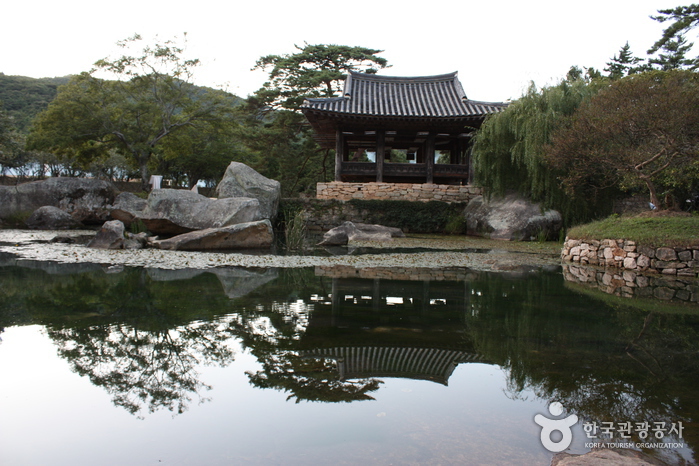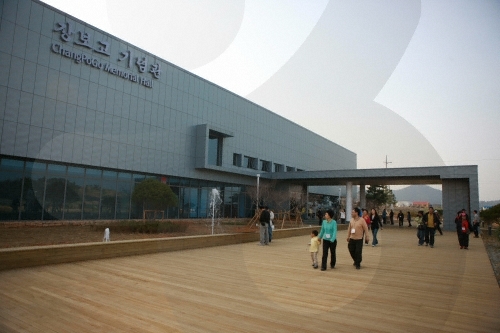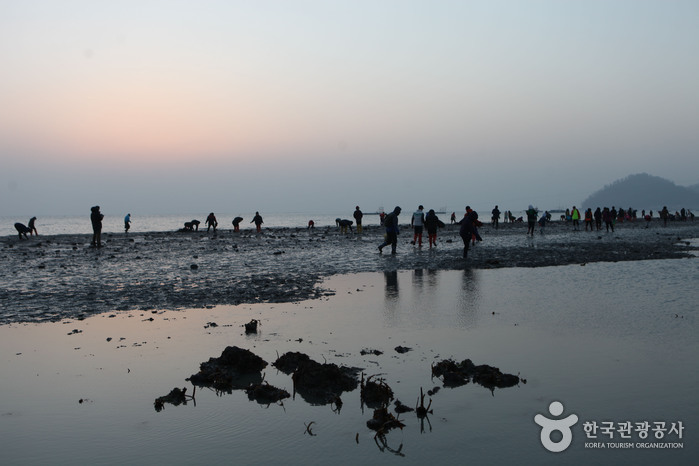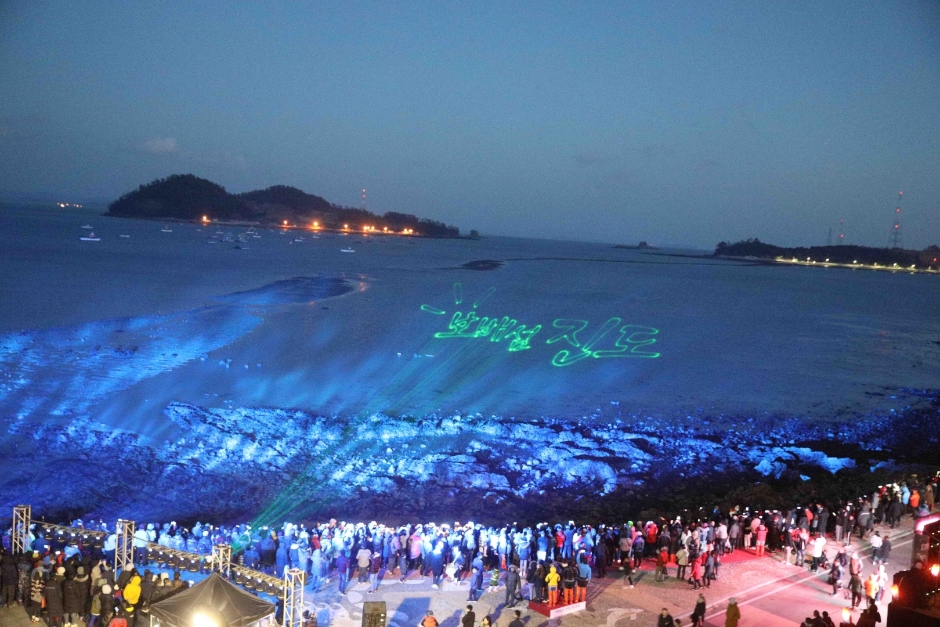Nohwado Island (노화도)
16.0 Km 5710 2022-06-20
813, Nohwa-ro, Wando-gun, Jeollanam-do
+82-61-550-5152
Nohwado Island, a stopping point en route to Bogildo Island, is well known for its abalone and mussel production. The island produces 70% of Korea's cultivated abalone, and offers seashell harvesting programs. Other attractions include Nohwa Red Sea, Geuknaksa Temple, and the 450-year-old hackberry tree.
Wando Jeongdo-ri Gugyedeung Pebble Beach (완도 정도리 구계등)
17.1 Km 33718 2024-02-20
152-1 Jeongdo-ri, Wando-eup, Wando-gun, Jeollanam-do
Gugyedeung Pebble Beach is the area near in Wando Port. The rounded pebbles, such as those found at Gugyedeung Pebble Beach, Jeongdo-ri, have been smoothed and rounded by waves over tens of thousands of years. The unique sound of waves crashing against the pebbles is like a song, and the harmony between the sea and forest paths is beautiful, attracting many travelers.
Haemaru healingsoup [Korea Quality] / 해마루 힐링숲 [한국관광 품질인증]
17.1 Km 5747 2020-12-12
108-35, Donghae-gil Bukpyeong-myeon, Haenam-gun, Jeollanam-do
+82-10-2332-6303
'Haemaru Healing Forest is a guesthouse situated at the foot of Duryunsan Mountain, Haenam in front of Wondo Beach and surrounded by a cypress grove. The mountain, cypress grove, and beach are all visible from the main floored hall room. For this reason, many of the guests who stayed here say that the picturesque view seems to change day by day. The town where the guesthouse is located is specially designed as a 'hanok village,' consisting mostly of traditional Korean houses of Jeollanam-do. It is also widely known as 'Haenam Kimchi Village' because of their famous cabbages, which are grown in the natural environment and are used to make kimchi. Specifically, there are three villages in this area: 'Green Experience Village,' 'Farm Stay Village,' and 'Resort Village.' There is a public swimming pool in the area managed by the villagers and is very popular among visitors, with ticket sales reaching KRW 100,000,000 a year. One of the advantages of staying at this guesthouse is that it’s within a one-hour ride to a number of popular nature destinations such as Wando Cheongsando Island, Gangjin Dasan Chodang, Jangheung Cheongwansan Mountain, Woodland, and Yeongam Wolchunsan Mountain. Haenam is known as one of the best regions of Korea for enjoying the famous Jeolla-do cuisine, so visitors to Haenam are advised to try the local food. The villagers built these traditional Korean guesthouses so that their visitors can have a day of relaxation in nature, away from their hectic city life. With this mind, they used natural pinewood and red clay from Gangwon-do to build authentic traditional Korean houses and utilized traditional Korean tiles from Goryeong. The name 'Haemaru Healing Forest' was given by the owner of the guesthouse, with the subtitle 'A place where you can tell your story.' The guesthouse buildings are in 'ㄱ' shape. The main building, called 'anchae' in Korean, has floor area of 72m², which is big enough for up to 25 people. There are two rooms, a large living room, and a kitchen in this building. The rooms are furnished with sofa, television, air conditioner, refrigerator, and table just like an ordinary home so that guests can feel at home during their stay. The 'bakkatchae,' or 'detached house,' is a single room with capacity of 6 and is furnished with air conditioner and bathroom. The guesthouse is owned by a couple who still work in Seoul and need to travel back and forth between Seoul and Haenam frequently. They're both nature lovers, so their most favorite place in the house is the kitchen garden where they cultivate their own organic lettuce, perilla leaves, and chili peppers. The kitchen garden is open to guests who want to try the homegrown organic vegetables. Various experience programs are offered here as well, such as yunnori, dadeumi, jwibulnori, and kimchi making. Jwibulnori is a traditional Korean game played on the eve of Daeboreum or First Full Moon Day, where people burn dry grass on the ridges of rice paddies and fields and others spin cans of flames attached to the end of a stick or a sling. For safety reasons, this game is played with the consent and participation of the villagers, so be sure to ask the owner of the guesthouse when the game is played. It’s free for groups of more than 10 people. As for the kimchi-making class, it is offered by the guesthouse owner's younger brother and sister-in-law who live and run a kimchi factory in the village. They will teach you how to make kimchi, step-by-step, start to end. The kimchi-making class is a paid program, so be sure to ask the guesthouse owner how much and when the class is held.
Bogildo Island Seyeonjeong Pavilion (보길도 세연정)
17.2 Km 21312 2021-12-23
57, Buhwang-gil, Wando-gun, Jeollanam-do
+82-61-550-5761
Yun Seon-do (1587~1671), a non-military civil administrator and poet in the mid Joseon dynasty, could hardly contain his anger after hearing the news that the king had surrendered during the Byeongjahoran War (Chinese invasion of Korea in 1636). Following the events, he decided to live in seclusion by moving to Jeju Island. However, on the way to Jeju, he came across Bogildo Island and he was so inspired by its beauty that he ended up settling down on Bogildo instead.
For the following 13 years, he composed great poems such as "Eobusasisa (Fisherman's Song for Four Seasons)." Some of the mountain peaks and rocks named by him still remain on the island.
Seyeonjeong Pavilion was built by Yun Seondo and this is the birthplace of his literary works. On clear days, he would come to the pavilion with his family and let singers sing his verses.
Bogildo Island embraces both the Eastern outlook on nature and Neo-Confucianism ideology. While going around the island, visitors will get some semblance of how Yun Seondo harmonized man and nature through the combination of the island's natural and the man-made features.
Bogildo Island (보길도)
17.5 Km 115779 2021-09-04
Bogil-myeon, Wando-gun, Jeollanam-do
+82-61-550-5152
Located about 12 kilometers away from Wando Port, Bogildo Island was once inhabited by a famous Joseon poet named Yun Seon-do, who found the island by chance when he sought shelter from a typhoon he encountered on his way to Jeju Island. During his 10-year stay on the island, he built 25 buildings, including Seyeonjeong and Nakseonjae Pavilions. His most noted work "Eobusasisa" was also written here.
The island has three beautiful beaches, serving as a popular vacation destination. The southernmost Yesong-ri Beach is especially popular for its astounding views with a 1.4-kilometer stretch of pebbled shore with an evergreen forest nearby.
Modo Island (모도)
17.8 Km 16336 2017-02-22
12-3, Modo-gil, Jindo-gun, Jeollanam-do
+82-61-544-0151
In 1929, Modo Island was spotted by Kim Hae-gim on his way to Jeju Island. He called the island Ttiseom because of the multitude of ttipul grass, a grass native to Korea, on the island. There were also many houses with thatched roofs made with dried ttipul on the island. The name Modo Island comes from the Hanja characters for "Ttiseom."
Jungni Beach (중리해수욕장)
18.0 Km 12324 2021-07-14
Jungtong-ri, Wando-gun, Jeollanam-do
+82-61-550-6625
Jungni Beach is the best beach for swimming in the sea on Bogildo Island. The white sandy beach is long and the depth of the water is shallow enough for people to enjoy, even at 200 meters into the water. The beach is also lined with pine trees that provide shade from the hot sun. The road to the beach is also paved, making it easy to reach.
Within a little distance from Jungni Beach there is a small and beautiful beach called Tongni Beach. The silver sand is lined with pine trees and the water is shallow. During summer, visitors can access the shower booths, water fountains, and convenience store at Jungni Beach and Tongni Beach. Accommodations and restaurants can be found in the nearby village. Approximately 1.5 kilometers away, there is an evergreen forest (Natural Monument No. 40) and a river with large black rocks stretching 1 kilometer.
Chang Po Go Memorial Hall (장보고기념관)
19.3 Km 22212 2021-03-12
1455, Cheonghaejin-ro, Wando-gun, Jeollanam-do
+82-61-550-6930
The Chang Po Go Memorial Hall was constructed to celebrate the achievements and maritime pioneering spirit of Chang Po Go. The hall is an educational tourism space focusing on historical culture. The permanent exhibition hall is divided into four zones that display the life of Chang Po Go.
Jindo Mysterious Sea Route (진도 신비의 바닷길)
19.5 Km 43647 2023-02-17
148, Sinbiuibadat-gil, Jindo-gun, Jeollanam-do
+82-1588-9601
Jindo Island is the third largest island in Korea, next to Jeju Island and Geoje Island. It is made up of 250 smaller islands, and it is famous for a strip of dry road that appears from the middle of the sea, near the end of February and mid-June of the lunar calendar. As it resembles a passage in the Old Testament in the Book of Exodus, the event is called “The Miracle of Moses.” When the water recedes, a road about 30-40 meters wide and 2.8 kilometers long appears and stays for about an hour before being submerged again.
Jindo Island has some legends which are still popular today, especially that of “Old Woman Bbyong of Hoedongri.” A long time ago, there were many tigers on Jindo Island. When tigers began appearing frequently in the village, the people fled to Modo Island. In the process, only the old woman Bbyong ended up remaining on the island, so the lady prayed every day to Yongwang, the god of the ocean, to let her see her family again. Around February, Yongwang appeared to her in her dream and said, “I will send a rainbow to the sea tomorrow; ride it and cross the ocean”. The next day old woman Bbyong went out to the sea and prayed again, and the seawater parted as the rainbow road appeared. Through this road, her family and the other villagers came back to the island. Therefore when the sea parts, the people celebrate this phenomenon by holding the Yeongdeung Festival to remember the Old Woman Bbyong. During the Festival, original folk plays of Jindo Island are performed and draw many tourists to Jindo Island.
Jindo Miracle Sea Road Festival (진도신비의바닷길 축제)
19.8 Km 138765 2024-02-07
74 Sinbiuibadat-gil, Jindo-gun, Jeollanam-do
+82-61-540-3407
The Jindo Miracle Sea Road is a 2-kilometer-long path connecting two islands that only appears for approximately one hour at extreme low tide. Many visitors gather in the area every year to witness the splendid phenomenon.

![Haemaru healingsoup [Korea Quality] / 해마루 힐링숲 [한국관광 품질인증]](http://tong.visitkorea.or.kr/cms/resource/35/2049835_image2_1.jpg)




 English
English
 한국어
한국어 日本語
日本語 中文(简体)
中文(简体) Deutsch
Deutsch Français
Français Español
Español Русский
Русский